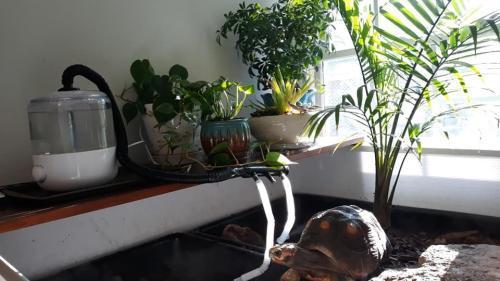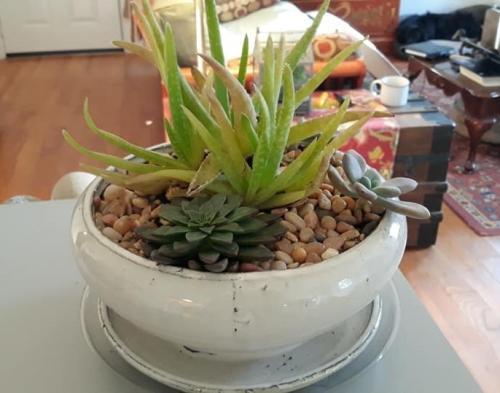Overwintering: Should I treat my indoor succulents differently during winter?
This idea relates to winter care for succulents growing indoors. The intent is to describe the important factors governing how they should be treated during this period. I am not attempting to address the treatment of outdoor succulents during winter, or even greenhouse plants necessarily (though there may be some overlap). This idea probably is most relevant to people growing succulents in the subtropics or temperate locations, where there is an actual winter.
HARD WIRING
What is the plant's preferred growing season? A small minority of succulents are winter growers, to they extent they have a preferred season of growth (fall through spring) and a season of rest (summer). Aeonium and Dudleya fall into this category, and they resent low light conditions during winter. Without an unusually bright location, they may not be suitable for cultivation indoors for this reason. These plants come from a winter-rainfall (dry summer) climate. They complain loudly when water is withheld during winter.
In contrast, some plants (eg. Adenium, Pachypodium) may be summer growers, and rest during winter. The rest is obligatory for some of them, and it is important to respect that rest by withholding water (partially or completely) when they are leafless. Some plants need to be treated differently during winter, no matter how easy conditions may be.
TEMPERATURE
However, most succulents will grow year round when conditions are permissive. This occurs outdoors in our very mild zone 11 climate (annual min./max. = 46/90°F). After our coldest nights, the daytime temperature outside usually gets into the 60s. So there is no cold to speak of, especially indoors. The winter temperatures here are not unlike what you might experience indoors in a place that gets cold outside. Daytime temps in the 60s-70s and occasional nighttime temps in the 40s are perfectly within the acceptable year round growth tolerance of the vast majority of succulents in cultivation.
Is that what your plants experience indoors during winter? Temperatures below this approximate comfort zone begin to approach the range where many succulents (depending on their hardiness) may need less water, less often. The combination of dim light and low temperatures is particularly likely to trigger dormancy and mean you need to water less.
LIGHT
A good rule of thumb indoors is the more natural light, the better. The best position for your succulents is right in front of an unobstructed southerly facing window (assuming you're in the northern hemisphere), where they can "see" the sun for hours a day year round. Strong light means a line of sight to the sun, not reflected/diffused/ambient sunlight, not sunlight diminished by a curtain or blinds.
Late fall and winter bring about changes in light that relate to intensity and duration. Winter days are shorter (here in the subtropics they dip to 10 hours long). The sun does not rise as high in the sky (here in the subtropics that's 32° above horizontal, meaning the sun gets only a third of the way to vertical in early winter). The winter sun does not travel as far from east to west in the sky. It is more likely to be blocked by objects on the horizon.
The best way to figure out what's happening with the light is to observe your plants first-hand, to see what's making shadows and how far the sun is actually penetrating indoors. If your plant cannot "see" the sun for hours a day during winter, you need to consider backing off on the water until conditions improve. Or you may wish to consider artificial light, which is a whole 'nother ball of wax that I'm not going to talk about here.
WATER
When you are trying to decide how to water, consider the question of how fast the soil will dry out at depth. This will generally happen faster during summer and slower during winter, all things equal. It will happen faster in small pots compared to big ones. It will happen faster in unglazed clay pots compared to plain plastic or glazed ceramic ones.
The process of evaporation is accelerated by strong light and warmth, slowed down by low light and cool temperatures. If the environment where you keep your plants is cool and dark during winter, you will need to reduce the watering frequency, and perhaps the watering amount, during late fall and winter. In contrast, if the area is warm and dry (thanks to heating) and remains bright during winter, you may actually need to water more often then. I water my plants (SW facing windows) the same year round, approximately.
For most succulents, given moderate temps (like room temperature in most places) and strong light (like a southerly-facing windowsill) there is no particular benefit to withholding water during winter. This would mean watering well when you do water (ideally watering past saturation) and then waiting for the soil to dry out most or all of the way at depth before watering again. Allowing the soil to remain bone dry for any extended period (like withholding winter water) does not work to your advantage with most succulents, given mild conditions. It may make more sense if they are in a cool, dark place (like a garage or a basement), as would watering to some point short of completion. Allowing the soil to remain wet or moist at the bottom, especially in combination with cool and dark conditions, is a recipe for rot.



